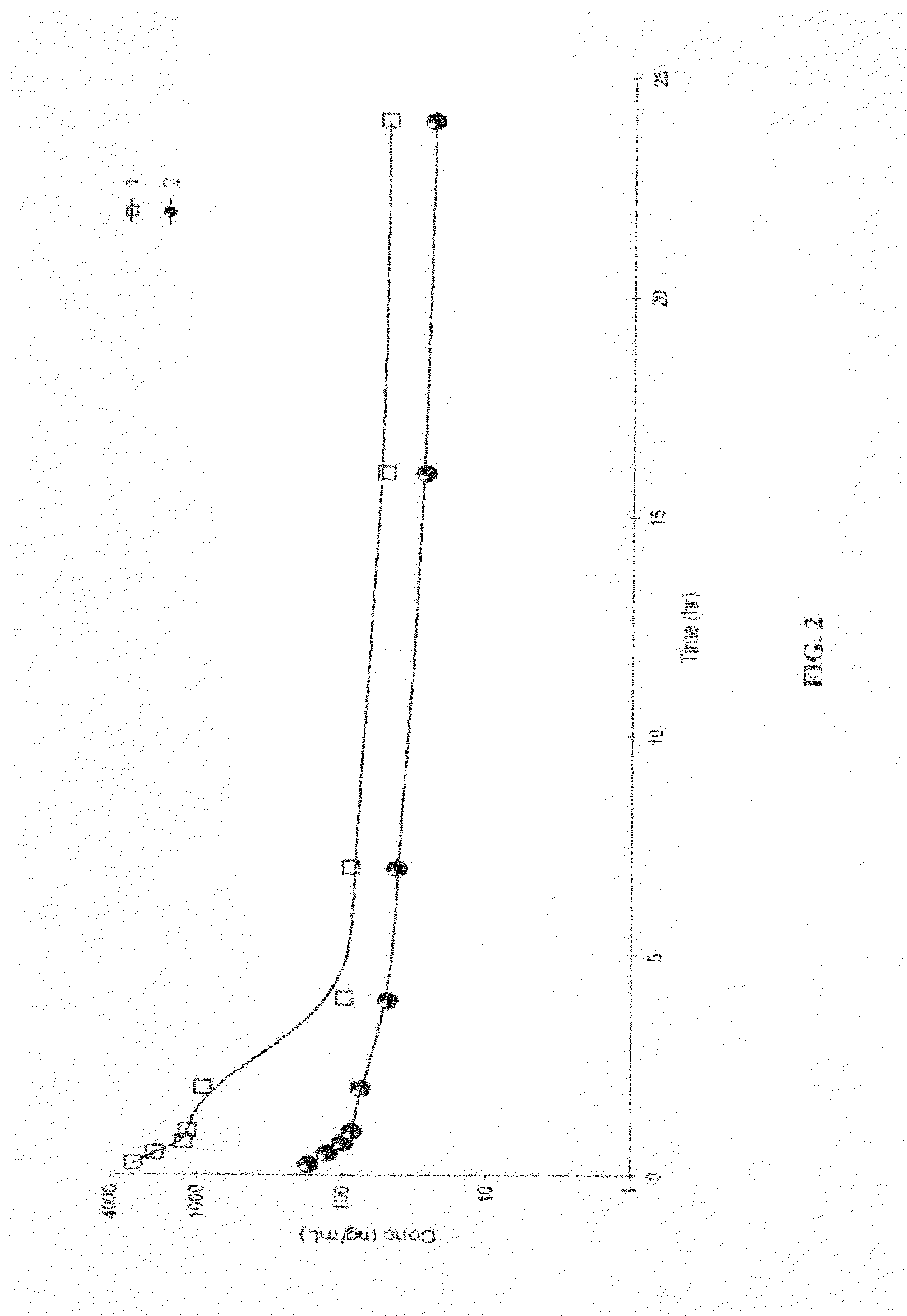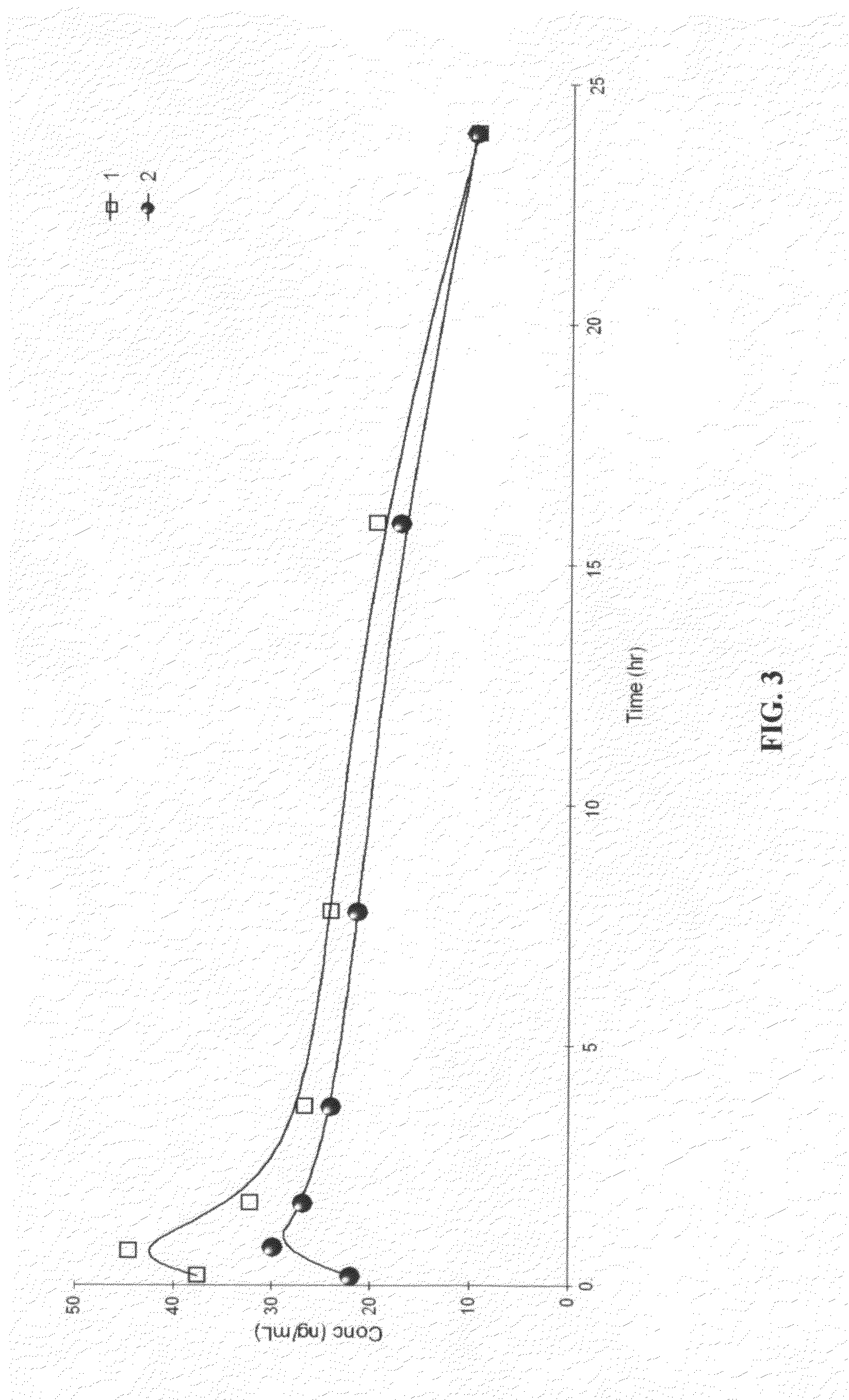Pure PEG-lipid conjugates
a technology of polyethyleneglycol and lipids, applied in the field of polyethyleneglycol (peg)lipid conjugates, can solve the problems of difficult to achieve a mono-distribution of purified pegs and extremely expensive pegs, and achieves low cost of starting materials, high product yield, and simplified synthesis
- Summary
- Abstract
- Description
- Claims
- Application Information
AI Technical Summary
Benefits of technology
Problems solved by technology
Method used
Image
Examples
example 1
Synthesis of 3-Oleoyl-1,2-bis(methoxyhexathylene glycol)glycerol
Part 1A: 3-Benzyl-1,2-bis(methoxyhexathylene glycol)glycerol
[0125]To a three-necked flask, (±)-3-Benzyloxy-1,2-propanediol (1.2 g, 6 mmol), NaH (0.96 g, 40 mmol) and dry THF (150 mL) were added. A dry THF solution (50 mL) of monomethoxyhexaethylene glycol tosylate (5.4 g,12 mmol) was then added to the mixture dropwise at room temperature. The mixture was refluxed for 24 hours and cooled to room temperature. Ice-cold methanol was added to the reaction mixture to quench excessive NaH. The solvent was evaporated and the crude product was extracted with 5% HCl (w / v) and CH2Cl2. The solvent was evaporated and further purified by gel permeation chromatography to yield 85% of colorless liquid.
Part 1B: 3-hydroxyl-1,2-bis(methoxyhexaethylene glycol)glycerol
[0126]To a solution of 5 grams of 3-Benzyl-1,2-bis(methoxyhexaethylene glycol)glycerol in 20 mL of n-Hexane, 5 drops of acetic acid and 0.6 g of palladium black were added. Th...
example 2
Synthesis of 1,2-dioleoyl-rac-3-monomethoxydodecaethylene glycol (mPEG-12)-glycerol
[0128]The general steps for this synthesis are showed in Reaction Scheme 8.
[0129]1 moles of hexaethylene glycol was mixed with 0.15 moles of pyridine and heated to 45-50° C. and 0.1 moles of trityl chloride was added. The reaction was carried over night (approximately 16 hours) under constant stirring and then cooled down to room temperature and extracted with toluene. The extract was washed with water, then extracted with hexane and dried over MgSO4. The solvent was removed under vacuum, a light yellow oily Tr-hexaethylene glycol was obtained (yield 70 to 85%).
[0130]0.1 moles of Tr-hexaethylene glycol and 0.101 moles of p-toluenesulfonyl chloride were mixed in 100 mL of methylene chloride. The homogeneous mixture was cooled to 0° C. in a dry-ice-acetone bath and 45 g of KOH was added in small portions under vigorous stirring while maintaining the reaction temperature below 5° C. The reaction was comp...
example 3
Synthesis of 1,3-dioleoyl-rac-2-monomethoxyDodecaethylene glycol (mPEG-12)-glycerol
[0137]The general steps for this synthesis is showed in the following scheme (Reaction Scheme 9):
[0138]0.033 moles of dihydroxyacetone was constantly stirred under nitrogen in 150 mL of chloroform. 0.06 mole of oleoyl chloride was dissolved with 150 mL of chloroform and added to this heterogeneous mixture of dihydroxyacetone and followed by adding 10 mL of anhydrous pyridine. The reaction proceeded for 30 minutes under constant stirring at room temperature. The mixture turned homogeneous and the reaction was completed when no detectable oleoyl chloride was in the mixture. The bulk solvent was removed under vacuum. The residue was wash with water then extracted with ethyl acetate. The aqueous phase was repeatedly extracted with ethyl acetate and the organic layers were combined and washed again with water, dried over sodium sulfate and evaporated. The resulting oily product was recrystallized from meth...
PUM
| Property | Measurement | Unit |
|---|---|---|
| molecular weights | aaaaa | aaaaa |
| molecular weights | aaaaa | aaaaa |
| molecular weight | aaaaa | aaaaa |
Abstract
Description
Claims
Application Information
 Login to View More
Login to View More - R&D
- Intellectual Property
- Life Sciences
- Materials
- Tech Scout
- Unparalleled Data Quality
- Higher Quality Content
- 60% Fewer Hallucinations
Browse by: Latest US Patents, China's latest patents, Technical Efficacy Thesaurus, Application Domain, Technology Topic, Popular Technical Reports.
© 2025 PatSnap. All rights reserved.Legal|Privacy policy|Modern Slavery Act Transparency Statement|Sitemap|About US| Contact US: help@patsnap.com



